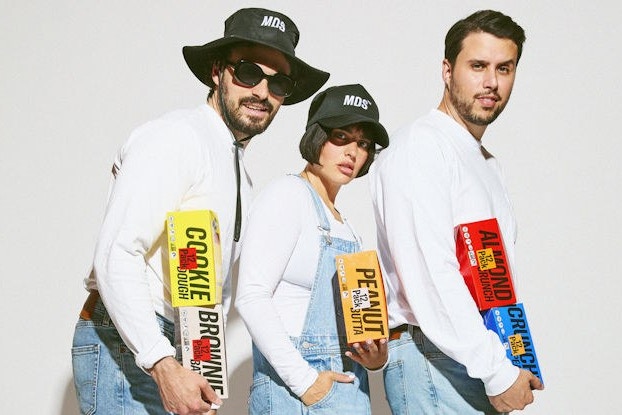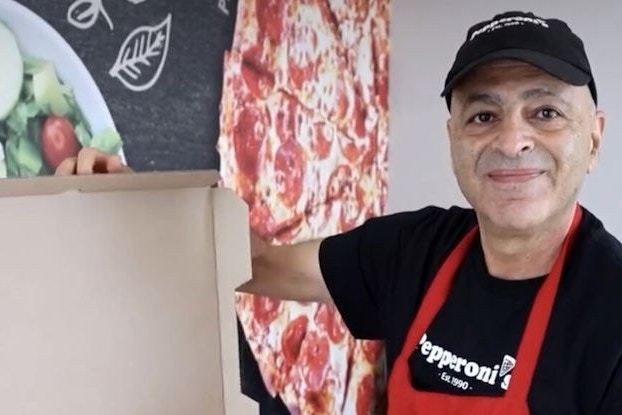
Why it matters
- The number of CEOs actively engaging on social media has doubled over the past two years, according to a survey by FTI Consulting.
- Eighty-five percent say their relationships with stakeholders have improved by actively engaging in social media, the survey revealed.
- For this to work, you need to have a long-term strategy that sets goals, whether it is to increase sales by a certain percentage a year or build brand recognition, founders and CEOs told CO—.
It is not easy for a startup to launch a brand and carve a niche for itself in a market dominated by corporate titans. But Jake Karls, Co-Founder of Mid-Day Squares, a chocolate bar company in the growing “functional,” better-for-you-ingredients market, has successfully used social media to become an influencer and build a loyal customer base — despite competition from Hershey’s and Mars that together control the lion’s share of the chocolate market in North America.
In seven years, he and co-founders — sister Lezlie Karls, CEO, and her husband Nick Saltarelli — have turbocharged company sales via authentic storytelling on such platforms as LinkedIn, Instagram, TikTok, Facebook, and Spotify.
Today the business produces 135,000 chocolate bars a day and sells its product in 9,500 retailers across the U.S. and Canada, including Costco, Target, Whole Foods, and Sprouts Farmers Market. Mid-Day Squares has sold over 55 million bars since its launch, and sales are now $35 million annually. That’s quite a feat when you consider in the early days Karls and his partners hand-made the bars — a hybrid between a protein and chocolate bar made with all natural ingredients — on the kitchen table in his sister’s condo.
“We have grown a large fanbase on social media by posting stories and videos that give people a behind-the-scenes look at what it takes to launch and grow a startup,” said Karls, who calls himself the company’s “rainmaker,” noting last year he and his co-founders got 32 million views on TikTok, Instagram, LinkedIn, and Facebook.
“It’s like reality TV. We have built a powerful emotional connection with our audience. People love the fact that our stories document the drama entrepreneurs face daily: the good, the bad, and the ugly. And they are inspired because we emphasize how anyone can win by believing in themselves,” he explained.
For instance, a series documented the brand’s three-year journey trying to get into Costco Canada. After years of pitching the giant retail chain and not getting in, Mid-Day Squares’ founders alerted its followers on social media sites such as TikTok that it finally broke into the retailer, issuing a call to action to support their launch at the warehouse club chain and come sample and buy their product. The stunt ended up breaking Costco Canada’s road show first-week sales record for a food product. That in turn helped convince the retailer to distribute Mid-Day Squares’ product nationally.
After that success, Karls and his co-founders doubled down on storytelling to keep the sales momentum strong.
We have grown a large fanbase on social media by posting stories and videos that give people a behind-the-scenes look at what it takes to launch and grow a startup,' said Karls. 'It’s like reality TV. We have built a powerful emotional connection with our audience.
Besides developing a loyal customer base, Karls said there have been other key benefits of using this marketing approach. Over the years, it has helped the company’s executive team grow their business connections and attract investors, including Siddhi Capital, which led a $10 million venture capital round two years ago after a member of the firm saw a video Karls posted on LinkedIn and became intrigued about Mid-Day Square’s product.
The art of storytelling: ‘You have to build a personal brand just like you build a business.’
But taking a page from Karls’ playbook is not easy. You must be willing to constantly put yourself on camera and come up with authentic storytelling. Not everyone is up to this challenge — or is great at developing engaging content.
For this to work you need to have a long-term strategy that sets goals — whether it is to increase sales by a certain percentage a year, or build brand recognition, said Paul Segreto, CEO of Acceler8Success Group, a consultancy that advises small business owners on a host of business and management issues, including how to develop a personal branding strategy.
“You have to build a personal brand just like you build a business,” he said. “It takes time, commitment, and investment.”
Recognizing the benefits of this personal-branding strategy, the number of CEOs actively engaging on social media has doubled over the past two years, according to a survey by FTI Consulting. Eighty-five percent say their relationships with stakeholders have improved by actively engaging in social media, the survey revealed.
So how does one get started? First you need to tailor your content to each platform’s demographic, according to Segreto. For example, LinkedIn has a business audience that is interested in topics related to the workforce, careers, and business success, while Instagram has a younger audience that loves lifestyle content.
Keep in mind, you need to post content regularly— three to four times a week — and engage with your audience by responding to comments and inquiries, social media marketing experts said. This helps build trust and a following.
“Eventually you build a community with your audience,” Segreto noted.
“Be sure to post about things you and others are passionate about and have others amplify your message,” said Ryan Detert, CEO of Influential, an influencer marketing division of Publicis Groupe. “You need to educate and provide some kind of value proposition to drive engagement.”
[Read more: How 3 Franchise Entrepreneurs Built Multimillion-Dollar Businesses]
Building a fan base of customers can lead to big B2B clients: ‘The brand deals have had a multiplier effect on revenues.’
The benefits of becoming a CEO influencer can be huge. When a CEO builds a strong personal brand, he or she humanizes the company, builds trust and credibility, and drives business growth by attracting investors, customers, and talent.
Attorney Mike Mandell, Founder of LawByMike and one of the leading law influencers on social media with over 30 million followers, started posting on TikTok five years ago to drum up business for his family’s law practice. Realizing many people were interested in legal tips on commonplace issues, Mandell thought he could do a public service and help educate the public on their legal rights.
After six weeks of pushing out short-form video content on TikTok, one of his posts titled “What To Say If The Cops Pull You Over” when you might have exceeded the speed limit went viral and in two days got 50 million views. That’s when he decided to start his own firm and become a legal influencer.
He continued creating content on an array of topics, from what to do if you are injured in an accident to things your boss can’t do in the workplace. And soon he realized that he could expand his audience by posting the same videos on Facebook, Instagram, and YouTube. Two years later he also began translating the videos into Spanish.
“Knowing I can help people has been a driving force in my work,” said Mandell, who now has 30 million followers across TikTok, YouTube, Instagram, and Facebook. “So many people reach out to me to thank me for helping them resolve their issues every day.”
This work has helped Mandell build his client base. He now has 200 clients. At the same time, being an influencer has led to brand deals with such companies as Adobe and Surfshark. Under these partnerships, he acts as the content creator and influencer in long-form videos promoting their products and services in exchange for a fee.
“The brand deals have had a multiplier effect on revenues,” said Mandell, who expects $2 million in revenue by year-end. “But any brand deal must align with my values. Audiences know when you are not being authentic, and this can be a turnoff.”
[Read more: 3 Consumer Brand Founders and CEOs on Finding Growth in B2B Channels]
Tapping co-branded social media content and IRL events to widen audience reach
Ray Salti, Founder and CEO of Pepperoni’s, a takeout-only pizza brand that started franchising its concept six years ago, agrees. As a CEO influencer, he collaborates with other influencers on Instagram who are celebrity chefs and restaurateurs who share his passion for natural ingredients in food.
“By co-branding with them on content on social media, it’s helped me build awareness for my brand to a larger audience,” Salti said.

But being a social media influencer should be only part of a holistic marketing strategy, according to Salti. It should be accompanied by in-person events so you can interact with your followers and they can sample your product.
Supporting charities and local causes is also important. It helps a CEO build customer loyalty and respect, “since consumers want to support brands that do good for society,” he said.
That’s why Salti is on the board of The Halo House Foundation and participates in events with the American Heart Association, where he gives away free pizza to those who buy a Shop With Heart card, which is a discount card on shopping and dining that supports the AHA’s fundraising efforts.
In addition, Salti gets involved with other charitable events held by nonprofits and gives away gift certificates to Pepperoni’s restaurants — including high school kids in Texas who make the honor roll.
His strategy has worked well. Pepperoni’s now operates eight restaurants and has 14 franchises with 48 more locations in development, and it garners over $12 million in revenues annually.
“More and more CEOs realize social media can make or break you and your product, but you need to do it properly or it can backfire,” said Alessandro Bogliari, CEO of the Influencer Marketing Factory.
It works best when you leverage your authority and create content on topics you have expertise in, and on issues people can relate to, he noted. Above all, “Avoid overbranding. People don’t like to hear from CEOs who just brag about their companies,” Bogliari said.
CO— aims to bring you inspiration from leading respected experts. However, before making any business decision, you should consult a professional who can advise you based on your individual situation.

Interested in a small business membership?
Find out how the U.S. Chamber of Commerce can help your company grow and thrive in today's rapidly-evolving business environment. Connect with our team to learn how a small business membership can benefit your bottom line and help you achieve your goals.







